Mountaineering Basics: How to Get Into Mountaineering
Every mountaineer started out as a beginner mountaineer. We’ve all, at one point or another, asked, “How can I get into mountaineering?” and we’ve had to learn the mountaineering basics. And I’ll caution that it’s not the easiest sport to get started in – in fact most people don’t just jump into mountaineering without some sort of outdoorsy background.
Usually mountaineers will first start out as hikers and backpackers, and they may dabble in rock climbing. Then one day, they get the itch for more. What is all this mountaineering stuff anyways?
Even after I had been rock climbing, hiking, and backpacking for a couple years, I never once thought I would EVER get into mountaineering. I’m from Texas! I’m not into those cold-weather snow-hiking shenanigans (or so I thought).
However, one year, my buddy invited me to join a climbing club, and the first trip with the club was mountaineering. I nearly chickened out, but my friend made backing out practically impossible. He drove, he provided me with gear… he basically wouldn’t take no for an answer, and I’ll always be grateful for that. That first mountaineering trip was one of the hardest things I had ever done in my life up to that point… and I was hooked.
I later went on to climb Mount Whitney, Mount Rainier, Mount Shasta, and failed and succeeded at many other mountains. To this day, mountaineering holds a special place in my heart.
It’s high consequence and often it can be miserable, but there’s nothing quite like achieving a summit after you’ve hiked for miles in snow and ice, up steep slopes, and sometimes across giant gaping crevasses. It’s an addicting thrill.
Mountaineering makes you feel alive. It makes you feel strong, and courageous, and at the same time it can bring you to your knees. It’s like the entirety of human emotion in one objective... massive regret and doubt mixed with massive elation and courage. There's something beautiful about that (or I guess I'm into that kind of thing). It's one of the main reasons I like the outdoors... I feel fully alive.
So I’m excited to showcase mountaineering and introduce you to the basics here on She Dreams of Alpine, and I’m happy to introduce my friend, Meg, another badass female mountaineer, who wrote this guest post on beginner mountaineering. She will take us through some of the essential mountaineering basics and 15 tips on how to begin mountaineering. If you’ve ever thought to yourself, “I want to be a mountaineer,” then this one is for you.
So without further ado, here is all of Meg’s amazing advice about how to start mountaineering!
To learn more about Meg, check out her full bio at the bottom!
Perhaps you dream of standing on an airy summit surrounded by dramatic rocks, looking down below you. All you see is a sea of peaks enveloped by a tall pyramid shadow of the peak you stand on. But what does it take to climb a mountain anyway? How do you begin to get started with mountaineering?
Mountaineering (or alpinism) is a life-long love affair with learning how to suffer in a beautiful environment. Sure, standing on the top of a mountain is a romantic notion, but the days spent freezing your ass off to get there can put some things in perspective.
What IS Mountaineering Anyway?
The definition of mountaineering has always been a little vague in my book. Is it climbing a mountain? Does it require special gear? Do you need to reach an elevation threshold? The dictionary defines mountaineering as the “sport of climbing mountains.” But that doesn’t really clarify anything.
One thing you’ll quickly find about mountaineers is a lot of them have ego problems - fortunately, I don’t fall into that category. Mountaineering should be defined by YOU and YOU alone. If your goal is to summit a Colorado or California 14er, then that’s what matters.
Don’t let someone tell you that you aren’t an alpinist because you go on guided climbs or you don’t lead. This is your journey and your mountain. At the end of the day, mountaineering should be fun, whatever that means to you.
For me, the definition of mountaineering is climbing a mountain that requires a special skill. That skill could be route finding on rock and scrambling all the way to a full-on multi-pitch technical ice route complete with glacier travel.
Types of Mountaineering
One of the joys of mountaineering is the wide variety of mountain climbs. Perhaps you love to send pitch after pitch of rock up a 12,000-foot peak. Or maybe you prefer an endurance climb up 18,000 feet of snow. Below are a few different types of mountaineering and what each entails.
Alpine Climbing: Essentially rock climbing in the mountains. You’ll often need ropes, anchor materials, trad gear, belay device, and harness. These mountains are (typically) lower in elevation and less committing, since you’ll be carrying loads of gear.
Scrambling: This is rock climbing when a rope isn’t required. These mountains can be either tall or short and can take an afternoon or several days to summit. The only technical gear required is a helmet. (i.e. California 14er, Split Mountain)
Glaciated Peaks: These mountains contain snow year-round, but here’s the kicker, the snow and ice move along a glacier path. Special knowledge of glacier travel, team roped systems, snow anchors, crampons and ice ax are required. (i.e. Mount Rainier)
High-Altitude Mountaineering: This is for folks who like their air thin, think over 18,000-feet. Many of these mountains also require ice climbing, rock climbing, glacier travel, or snow climbing skills
Snow Climbs: This is the act of climbing a couloir (a deep, steep trench of snow) to reach the top of a mountain. This terrain may or may not be glaciated. Depending on steepness and competency, you may need ropes. Ice axes and crampons (think climbing Mount Whitney and Mount Shasta).
Alpine Ice Climbing: This type of climbing requires special ice axes, called ice tools, as well as ice screws, a dry rope, harness and anchoring material. This type of climbing can be a part of a glaciated peak, high-altitude mountaineering or even snow climbs.
Classes of Rock
The next nugget of knowledge you need to understand the basics of mountaineering is the different classes of rock. Of course, over the years, there have been a wide variety of classification systems. Here in the US, we use the Yosemite Decimal System (YDS) to categorize rock. Just keep in mind, much of this is highly subjective, and grading can be a hotly-contested topic for many mountaineers and climbers. Here are the different classes of rock:
Class I (1): Hill walking. This is essentially hiking. You will not be needing your hands and you walk along a hill or gravel. This is the easiest terrain. (Think White Mountain)
Class II (2): Commonly called rock hopping. You may need to occasionally steady yourself with your hands as you climb over bigger boulders, but the rock is not steep or technical and you can still hop across it. Exposure (or injury risk of a fall) is more common than Class I.
Class III (3): The point at which scrambling, or using your hands to climb over rocks, officially begins. Here you’ll be climbing over rocks and bigger boulders on steeper terrain, but you don’t need a rope for protection. The consequence of a fall could produce serious injury. Exposure is more apparent.
Class IV (4): Similar to Class 3 except the rock is steeper and the consequences of a fall more severe (read: could be fatal). I think of it as the grey area between Class 3 and 5.
Class V (5): This is the grade at which ropes and a belayer are recommended for protection. Rock is steep enough where a fall could easily be fatal. Class 5 rock is the point at which climbing becomes technical. The grading system starts at a 5.0 and goes all the way to 5.15. 5.0 to 5.4 routes are considered very easy, 5.5 to 5.7 is easy, and it goes up from there. Once you reach 5.10, the climbs are broken down into letter grades (e.g., 5.10a through 5.10d) before you reach the next number grade.
Climbing Grades by Time
Once you begin multi-pitching (climbing multiple pitches, or rope lengths, of rock) or alpine climbing there is typically a time grade associated with the climb as well. This grade runs from Grade I through Grade VI. Grade I climbs take a few hours, II a half day, III a full day, IV a dawn to dusk climb, and V is two days with VI being more than an overnight.
Ice Grades
Ice climbing grades operate much in the same way that rock grades do, using a WI (or water ice) in front of the number to indicate ice. Currently, WI grades run on a scale from one through eight.
15 Tips on How To Get Into Mountaineering
On the Rocks, Blended, or Extra Ice?
Each different type of climbing requires a different skill set. It takes years to become a well-rounded mountaineer who knows enough to handle any type of terrain.
At first, beginning mountaineering feels extremely overwhelming. In order to keep some focus, find an area or skill set that you want to develop and see where it takes you.
When I first started mountaineering, I wanted to climb tall, snowy mountains in the Himalaya. However, after a few years of practice, I found that I actually love weekend summits that are lower in elevation, but require technical rock skills.
Stay flexible and allow your love for the mountains to guide the type of climbs you’d like to tackle.
1. Finding Your Mountain
Getting into mountaineering often depends on your geographical location. For example, if you’re in California, you’ll want a solid understanding of both snow travel and rock skills. For those in the Pacific Northwest, glacier safety is essential. Colorado is more geared towards alpine climbing, while Alaska offers a bit of everything, including that menacing altitude.
There are plenty of resources out there to help you pick a mountain climb. Summit Post and Mountain Project offer an enormous amount of beta (climbing term for information) about various summits and climbs world-wide. Blogs are another great resource. Be sure to use the term “trip report” in your Google search to find firsthand information about what the mountain is like.
2. Height Doesn’t Matter
People love to get caught up in the elevation of their climb. Many times, the focus becomes tackling a list, such as climbing the Seven Summits of all 54 of Colorado’s famed 14ers. However, the mountain doesn’t care if you’ve checked some imaginary box in your mountaineering career.
The point is to have fun and enjoy your mountaineering adventures. Let go of what everyone else is up to and focus on growing your personal mountaineering career. This becomes important in making safe decisions on the mountain. Most fatalities in the mountains come from human error, and the mental aspect of mountaineering far outweighs your physical ability.
Want more proof that highest doesn’t mean hardest? Check out this National Geographic video on mountaineering.
3. Learn to be an Early Riser
Mountaineers love waking up well before the sun. This is often because of the threat of bad weather, melting snow, increased avalanche dangers and long days out on the mountain. If you can’t embrace waking up at 3 or even 12 am, mountaineering may not be the sport for you.
Use something you love to motivate you to rise early and stay out late. On days where I dread my 2 am alarm, I often think about the amazing morning light of a snow-capped mountain and the heaping pile of nachos I will get to destroy post-climb.
GRAB MY [FREE] OUTDOOR BACKPACKER STARTER KIT
I created the Ultimate Outdoor Backpacker Starter Kit for you (and it's FREE)! This starter kit is filled with 14 pages of my best hiking and backpacking tips to help you learn what it takes to become a safe, confident, and self-sufficient outdoor backpacker!
4. Acclimatize Properly
Even though I live in the Mile High City of Denver, I’ve still been a victim of Acute Mountain Sickness, or AMS, twice (once in my own backyard). Take time to acclimatize properly before heading to the summit. Your climb will determine how long acclimatization will take.
Here are a few helpful tips:
Stick to water. Avoid alcohol and caffeine on your way up or even in the day or two before your climb. You’ll want to drink PLENTY of water as you climb, because the higher you go, the thinner the air. This means there’s less moisture in the air, leaving you susceptible to dehydration.
Climb high, sleep low. This high-altitude mountaineering trick works well at lower elevations too. If you’re headed to base camp, consider taking a hike a few hundred feet up near camp, then walk back down and sleep at a lower elevation.
Garlic up. Garlic helps with acclimatization (it’s a common remedy in the Himalayas). Add garlic powder to your meal to help get you ready for altitude.
If symptoms get worse, descend. AMS can strike anyone at any time. Scientists don’t really know what triggers it. The important thing is to descend if your AMS symptoms (headache, nausea, coughing, lethargy) increase as this could be the onset of something worse to come, such as HAPE (high altitude pulmonary edema) or HACE (high altitude cerebral edema).
5. What Mountaineering Gear Do I Need?
The gear you will need heavily depends on the type of mountaineering you plan to do. For example, if you are a rock climber, you’ll likely have ropes, carabiners and trad climbing protection. Snow climbers will opt for dry ropes, snow pickets, a burly set of crampons and an accompanying axe.
You don’t have to get all of the latest and greatest gear in order to mountaineer. Many local companies and even guides offer gear to rent. This is often the most cost-effective option when getting started with alpinism, since mountaineering gear is not cheap.
However, there are a few mountaineering essentials that you’ll need, even if you aren’t getting into technical terrain. You don’t need to go bonkers—just identify the essential items you’ll need, decide what you can borrow or rent, and pick up things that will be specific to you or have multiple uses. Once you start learning mountaineering, slowly acquire the gear you need by finding discounts and sales.
6. Training for Mountaineering
A huge part of mountaineering is physical suffering, whether that be from the cold, long miles, steep gains, or spending countless days cooped up in a tent. Your body needs to be prepared for extreme conditions and able to carry lots of weight.
Backpacking in the mountains offers an excellent way to train for mountaineering by tackling lots of elevation gain with a heavy load. Depending on the climb, a mountaineering pack can weigh nearly 50 pounds.
Hauling that up 5,000-plus feet of gain is no easy task. You want strong shoulders, glutes, quads and hamstrings in order to climb a mountain. Focus on mountaineering training both for the uphill and downhill. Wear a weighted pack on a stairmaster or treadmill, engage your glutes and hammies with squat routines and work on your deep core muscles using a Bosu Ball.
Want more tips on how to start training for mountaineering? Check step two in my post on 7 Tips to Hiking and Summiting Your First 14er Peak for training details, and other tips on how to start mountain climbing.
7. Vaccinate Your Mind from Summit Fever
Sound decision making is the difference between life and death in the mountains. It is easy to stand 200 feet from the summit and think “Well, I’m so close, I can’t turn around now,” despite the ominous signs of bad weather approaching. This poor decision making can quickly become compounded when you are forced to turn around after investing countless hours (and money) preparing for a climb.
It’s disheartening to turn around, but every real mountaineer has done it, more than once. In fact, a 50-percent success rate or less is common in the mountains. You must keep mental discipline in order to mitigate risk.
Mountaineering is inherently dangerous, and your situation can deteriorate on a moment’s notice. Always be aware of your surroundings, the dangers on your particular climb, as well as your current mental state. A lot of this takes practice and experience to truly understand, but it’s essential that you always ask yourself “is this option safe based on what I know?”
8. The Summit is Only Half Way
Mountaineering is 20% physical and 80% mental. Everyone gets really excited for that perfect summit selfie, but it’s important to remember that the reaching the summit is only half the battle.
In fact, descending the mountain is the most dangerous part of any climb, and most accidents in mountaineering happen on the downhill. Your body is tired, the objective appears complete, and it’s easy to get complacent.
The wear and tear of the downhill on your joints can quickly cause injury. Remember that mental discipline? Well, now’s the time to unleash your mental prowess. Stay focused, keep safe, and pay attention to your footwork on the downhill. If you need to rappel (descend on a rope), always double check your system.
9. Understanding Consequence
You hear a lot of mountaineers and climbing guides talk about consequences. When you are faced with a choice in the mountains, it’s important to understand the consequence of that choice. Ask yourself “What’s the consequence if I fall here?” “What are the potential consequences if I glissade and can’t stop myself?” “What is the potential consequence if we push on despite signs of the weather turning?”
Evaluating consequence allows you to assess risk. Consequence is a part of every mountaineering decision, so think wisely and be vocal about your thoughts in a group setting.
10. Getting Past Fear
One of my favorite parts of mountaineering is looking fear in the eye and then moving past it. I’m terrified of heights, but I frequently climb mountains with steep drops and vertical rock. It’s taken me years to get comfortable with heights, but mountaineering allows me push past that fear.
My biggest tip for overcoming heights is to continue to expose yourself to heights. Join a climbing gym, challenge yourself to tip-toe to the edge of a cliff and look over – anything that helps you become okay with steep terrain will help your mountaineering career.
11. Get Your Alpine Degree
You can’t possibly learn everything you need to know about mountain safety from a blog or YouTube. Getting started with mountaineering takes an investment of both time and money. Consider taking mountaineering courses by certified American Mountain Guides Association (AMGA) instructors in order to learn specific mountaineering techniques.
Many outdoor stores, clubs and guiding services offer courses and are stoked to teach new mountaineers. Here’s a look at courses and skill sets that you’ll need to make your mountaineering career a success.
General Skills for Mountaineering
Don’t go climb a mountain without these basic mountaineering skills:
Navigation: map and compass skills
Rock navigation
Basic rock climbing techniques (how to leverage your weight, place your feet and properly climb and downclimb)
Avalanche safety and companion rescue. Consider getting your AIARE Level 1 or at the very least, take an avalanche awareness course if you plan on traveling on snow.
Wilderness First Responder or Wilderness First Aid. Rescue will take hours or even days in remote terrain, so know basic first aid before climbing a mountain.
Rock Skills for Mountaineering
If you plan on climbing technical rock, here’s what you’ll need to know:
Lead and top rope belaying
Lead climbing (if you plan on leading a pitched route)
Rappelling techniques
Trad leading and seconding (following) techniques
Basic anchors, trad anchors and alpine anchors
Climbing knots
Multi-pitch techniques: belaying from above, assessing and building the anchor, rope management
Rock rescue and belay escapes: not required, but strongly suggested
Haul systems: Not required but extremely handy.
Snow Skills for Mountaineering
Plan on getting into mountaineering on snow? There are a wide variety of snow skills depending on the terrain. Here’s a few essential mountaineering snow skills you’ll want nailed down:
Avalanche and snow science (I mentioned this above, but it is truly that important)
Safe use of crampons and ice axe, self arresting, and safe glissading
Snow anchors and roped team travel for glaciated terrain and/or steep snow
Ice climbing techniques. Similar to rock climbing techniques, only for mountaineering routes with ice climbs.
Haul systems and glacier rescue: If you are traveling on glaciated terrain
12. Mentorship in the Mountains
Now that you understand a little more about how to become a mountaineer, and you understand what skills you need to know to summit a mountain, it’s time to find a mentor. Mentorships have been made easier thanks to social media, and there are a wide variety of outdoor groups and guiding services where you can find your mentor.
As an experienced mountaineer, I enjoy teaching others from time to time, since there are many people out there that taught me. Let mentorships develop naturally or simply ask. A great mentee is open to feedback and always the first to volunteer to carry the heavy gear! Climbing mountains is a team effort, so be proactive in your mountaineering community.
13. Practice, Practice, Practice!
So now you’ve taken a variety of classes, maybe done a few climbs, and you’re fully embarking on your mountaineering career. A lot of the skills you’ve learned you won’t use on every climb, so it’s important to practice to keep your skills fresh so you have them dialed when you need them.
Find a low-consequence beginner mountaineering area near you (such as low-angled snow, or a climbing area designed for beginners) and practice different technical skills. Refreshing your skills before the start of the mountain climbing season will help keep you safe.
14. How to Find Mountaineering Friends
Most people think that the idea of climbing a mountain is slightly insane. I mean, doesn’t a nice night of Netflix and chill sound better than waking up at 12 am to engage in physical activity for 14 hours?
However, there is a community of freaks who live for the type 2 fun, and we are rather vocal about our, erm...untraditional lifestyle. Facebook groups and local Meetups are good places to find mountaineers. Many popular mountaineering states have outdoor clubs that not only offer classes, but group trips to get to meet fellow alpine nerds. You can even look for gender-specific groups, groups that share an interest in a particular type of mountaineering, and more.
Just be aware of the abilities of your new found friends, and be honest about your own skill level. Opt to go on a less committing adventure for your first time out with a new partner, maybe even just climb in a local gym or go on a leisurely hike. Ask questions about their climbing resume, what they enjoy about the mountains, and their stance on safety, so you can see if you’re both on the same page.
15. Get Out and Climb!
Beginning mountaineering opens up an array of outdoor skills to master. You’ll soar to new heights and experience a wilderness few people get to see. So go ahead and climb your mountain this season!
You can follow Meg and her adventures over on her blog, Fox in the Forest.
I hope you enjoyed this guest post from Meg that gives us some great tips on mountaineering for beginners. If you have any additional questions, hit us up in the comments below!
more essential OUTDOOR RESOURCES
If you’re looking for more outdoor resources, check out some of my other guides below!
7 Tips to Hiking and Summiting Your First Fourteener Mountain
10 Awesome Hiking Groups and Hiking Challenges to Encourage You on Your Hiking Adventures
Cheers,
Allison - She Dreams of Alpine

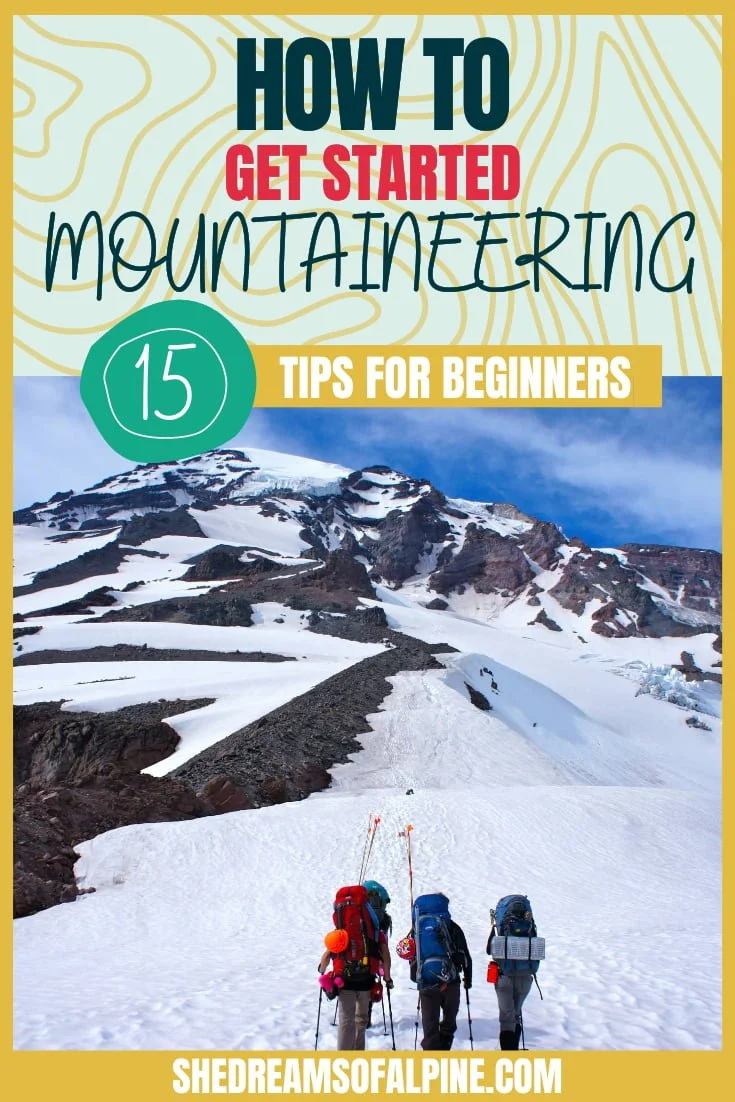

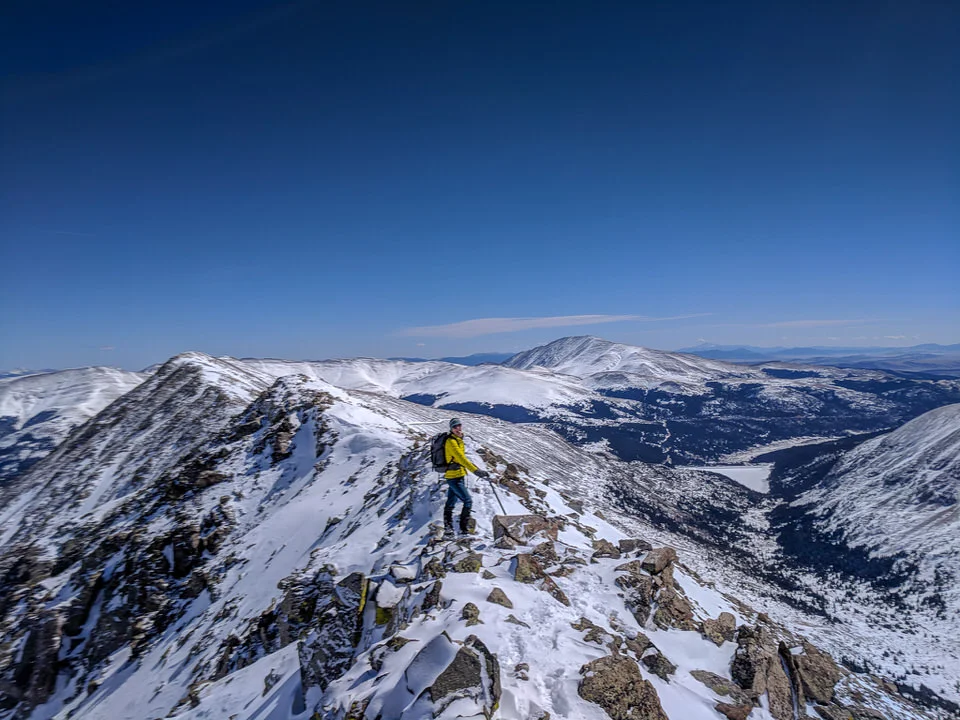
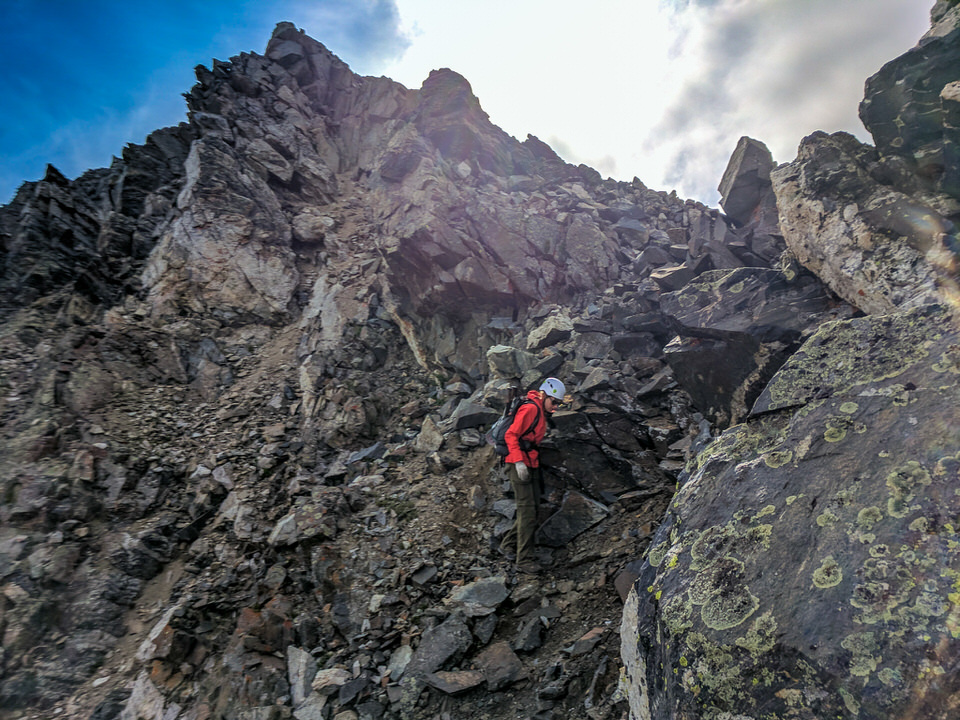
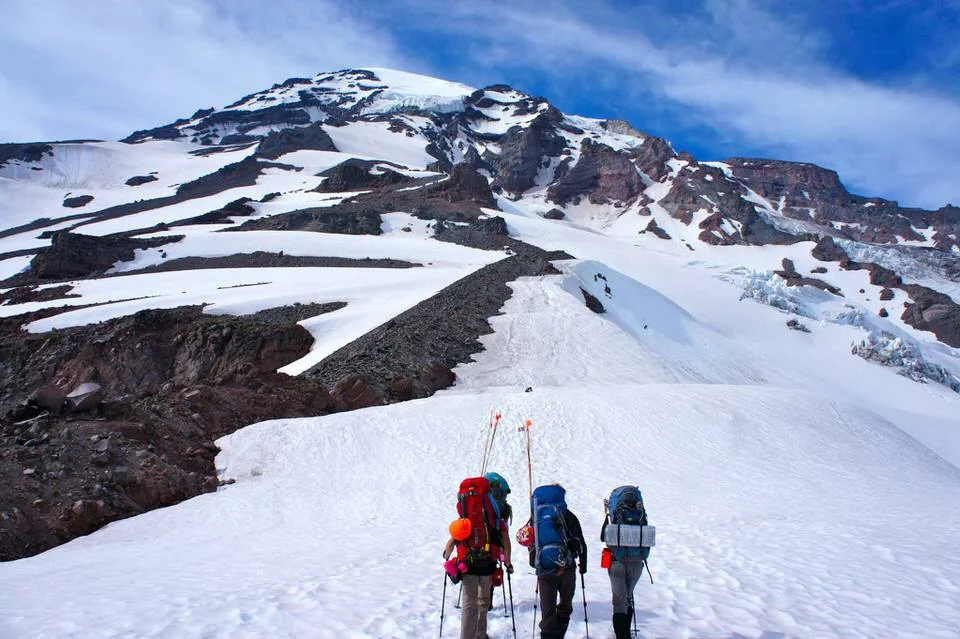

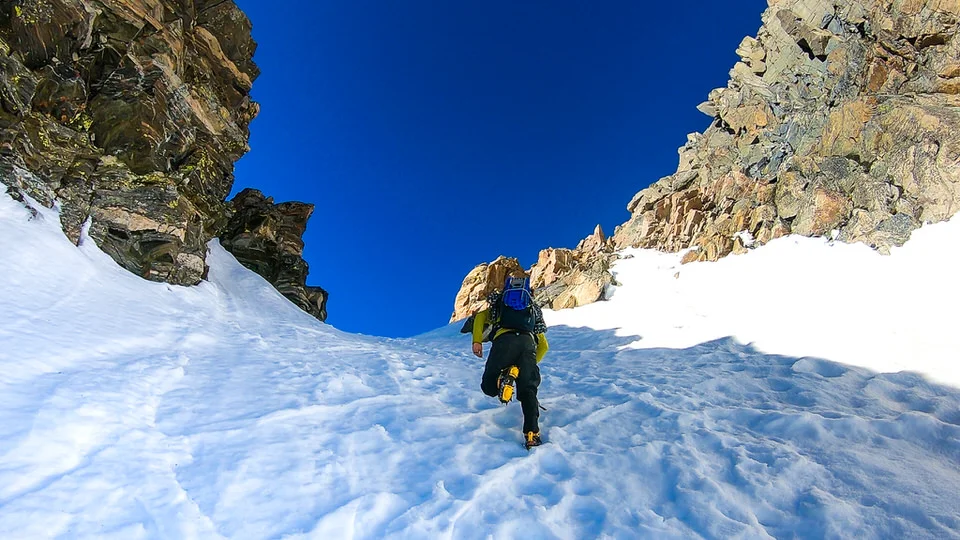
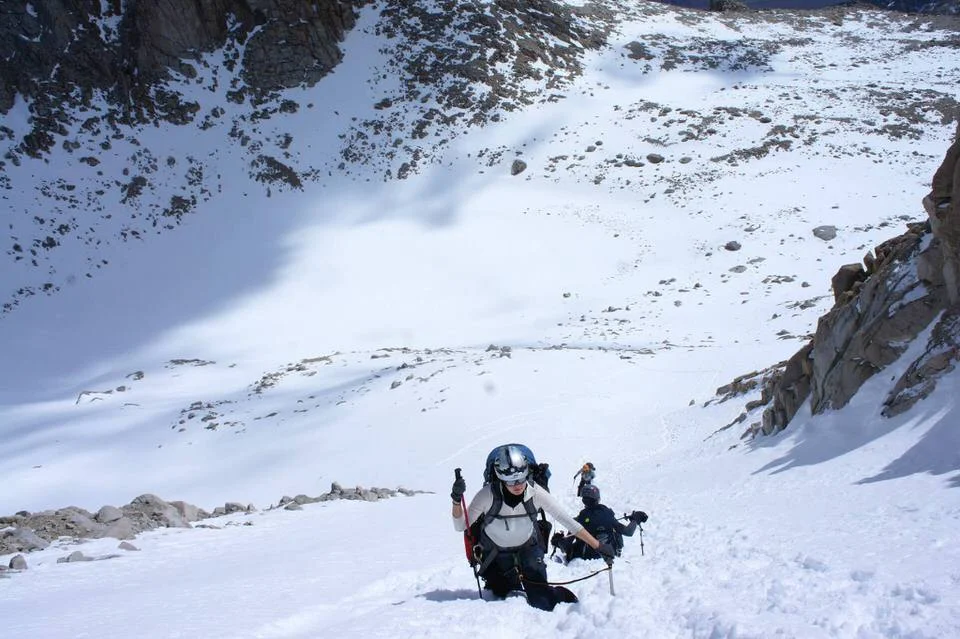

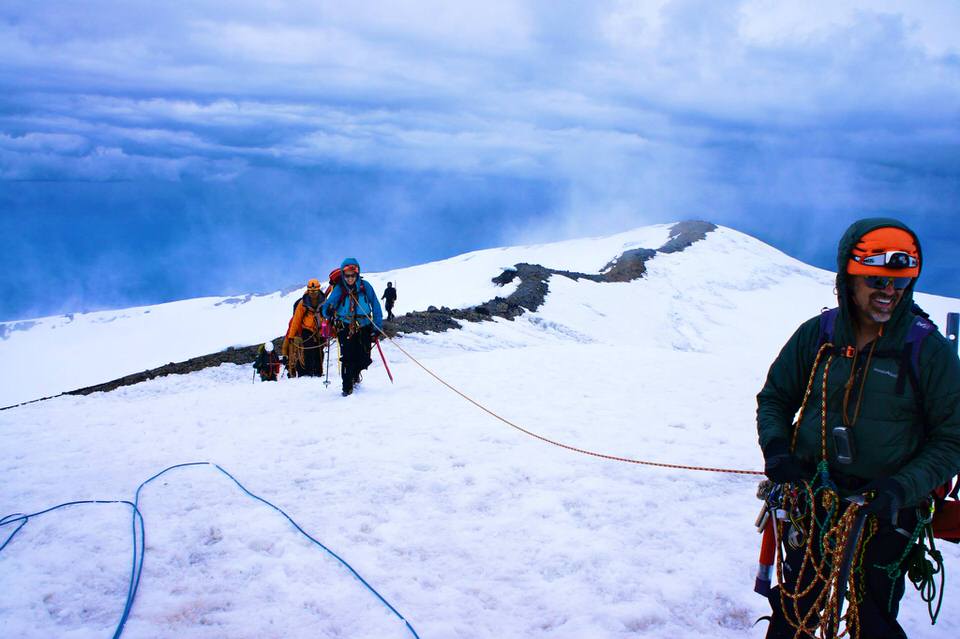
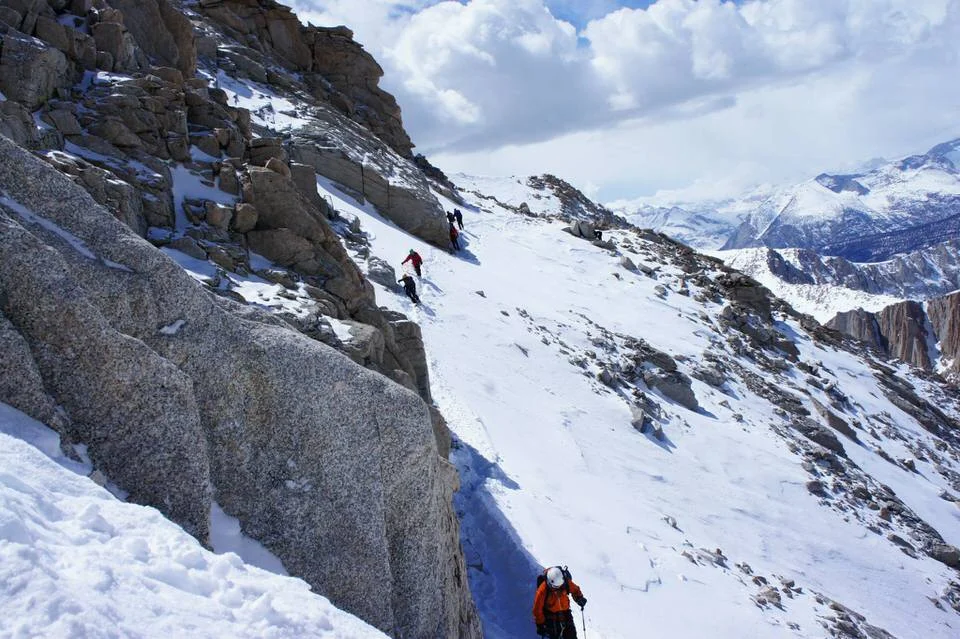


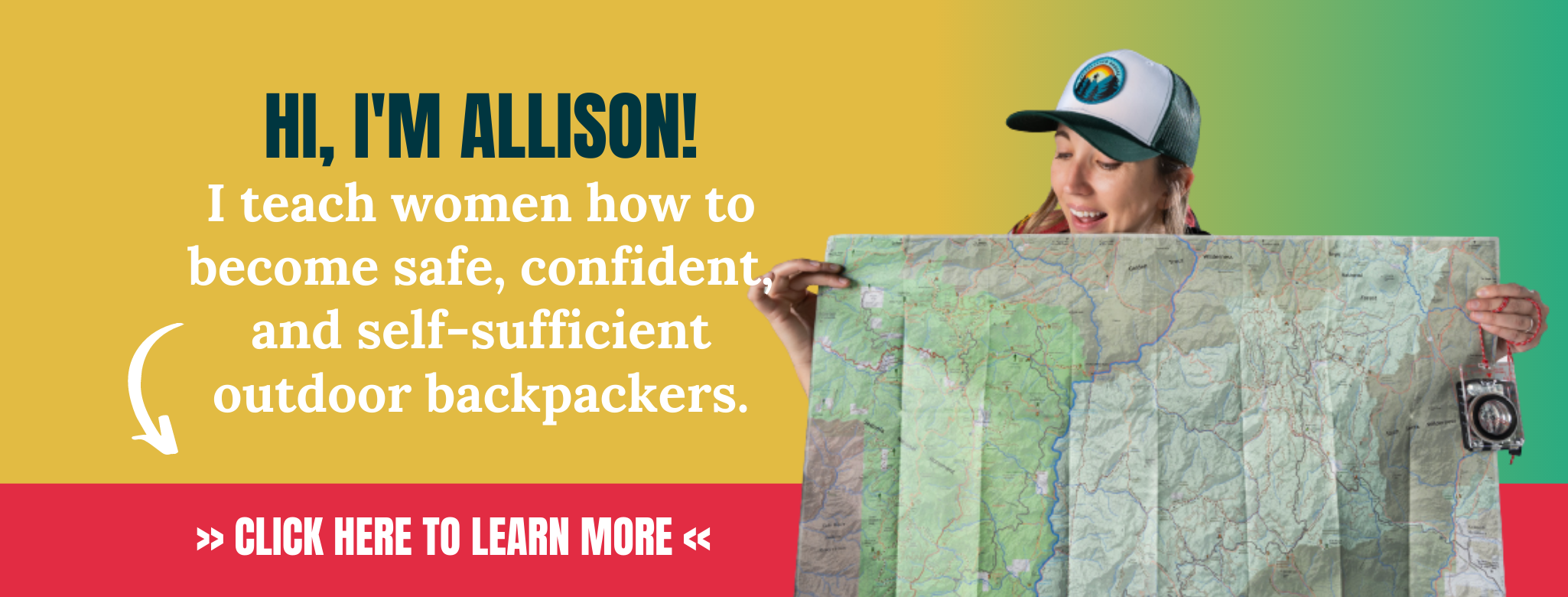









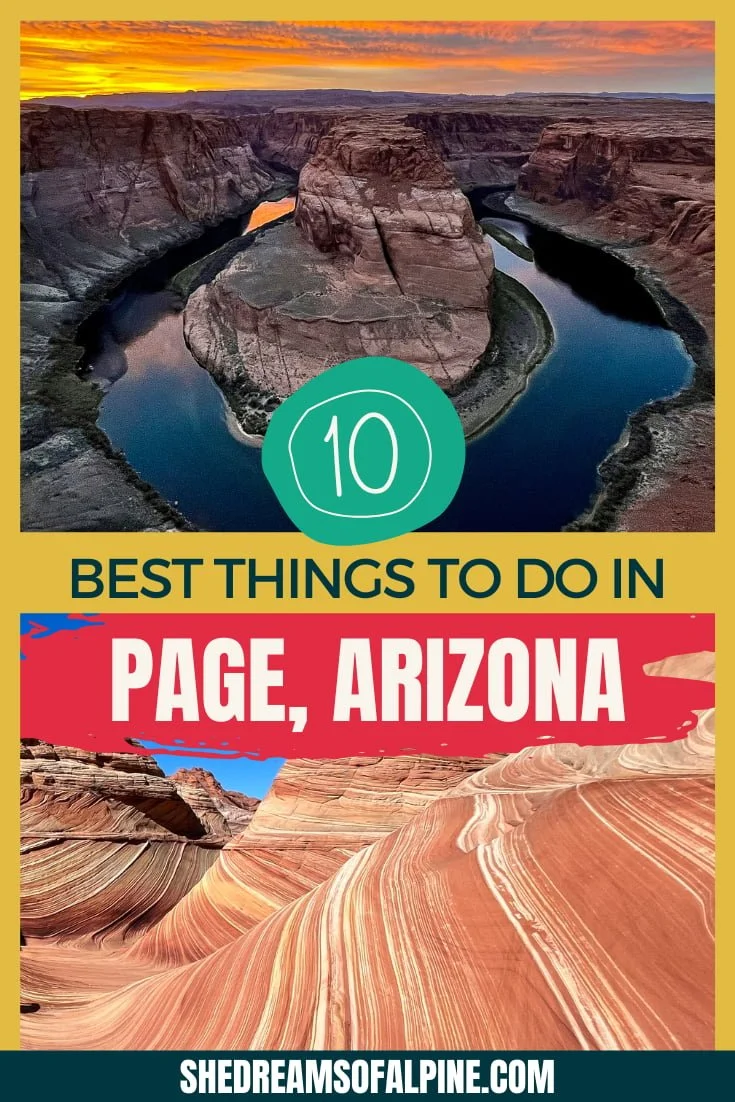
Important Permit & Reservation Deadlines for Popular California Hiking Trails & Campsites | Don't miss out on hiking or camping at some of Californias most popular sites because you missed the reservation deadlines. In this post I've outlined key deadlines to mark your calendars with for some of Californias most iconic locations such as Yosemite Wilderness Permits, Inyo National Forest Permits, Mount Whitney Permits, Half Dome Permits, JMT Permits, Joshua Tree camping reservations, Lost Coast backpacking permits and much, much more!. | shedreamsofalpine.com